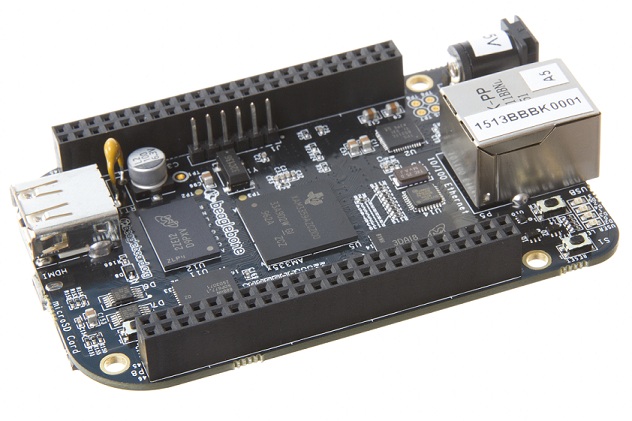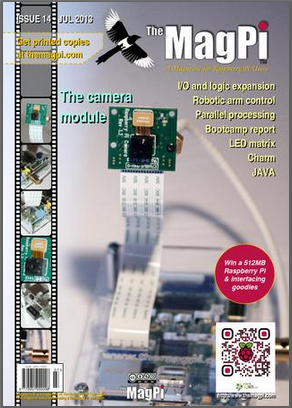Chris Swan has written a very balanced review of the BeagleBone Black and compared it to the Raspberry Pi on various criteria. It’s a great blog post that only falls down at the end when he concludes that the success of the BBB will spur a cheaper/better new Raspberry Pi model. I doubt that will happen in the short term – the community for the Pi is so strong, the Pi is already so cheap and the aims of the Foundation are met with the current models that there’s not much reason for them to push development on a potential model C.
Bare metal assembly language chess on the #RaspberryPi
Xu Ji, Bora Mollamustafaoglu and Gun Pinyo from Imperial College have created an assembly language chess game that runs on the Pi, without an operating system. There is a course on this kind of bare metal programming from Alex Chadwick of the University of Cambridge called Baking Pi if you want to get into it.
Picorder, version 2 – #RaspberryPi has sensor-y overload
Pardon the pun in the title, couldn’t resist.
Here is a two-part video I’ve just shot of the Picorder version 2. I’m just about to work on version 3, so it seemed the perfect time to document my work so far.
Part 1:
Part 2
Here’s a list of the sensors and bits and pieces that make up the Picorder:
- A Raspberry Pi (I know, I know, a stunning revelation) in a ModMyPi case.
- A 7200mAh USB charger battery pack.
- A Nwazet Key Lime Pi (which is essentially a Pi Cobbler with an onboard analog-to-digital converter giving 8 analog input/output pins) (also available from Pimoroni)
- A 16×2 character LCD display.
- A tactile switch / momentary push button.
- Two accelerometers.
- An Adafruit Ultimate GPS breakout board.
- A PCF 8591 board with onboard A2D, temperature sensor, light dependent resistor and potentiometer.
- A Piezo vibration sensor. (analogue, connected to the Key Lime Pi)
- A sound detecting microphone. (analogue, connected to the Key Lime Pi)
- A tiny temperature sensor (the type of which momentarily escapes me) (analogue, connected to the Key Lime Pi)
- A 61802H2 humidity sensor (analogue, connected to the Key Lime Pi)
Issue 14 of The MagPi published for #RaspberryPi owners
The July 2013 issue of the much-improved Raspberry Pi magazine “The MagPi” is now out.
Star-of-the-show is the camera module which is treated to an article by Broadcom’s James Hughes who wrote the software that drives the camera. There are also articles on:
- IO and logic expansion
- Making a low-cost GPIO expander (the Guzunty)
- Robotic arm control (using the Maplin robot arm)
- Parallel processing
- A report from a Boot Camp and how to create a family fun day with the Pi
- Using the Pi Matrix
- Charm on RiscOS (part 3)
- A beginners guide to JAVA on the Pi
Dave Akerman wins the Farnell/Element 14 #RaspberryPi camera competition
Dave Akerman, who launches high-altitude balloons as a hobby, has won the Farnell/Element 14 photography competition, voted on by the public. His photograph, a brilliant image of Devon and Cornwall taken at a height of almost 39km, stunned the Raspberry Pi world a few weeks ago and I think he’s a worthy winner.
The full press release from Farnell is below:
1 July 2013, London – An image of the Earth from 38.9km in the air has today been confirmed as the winner of element14’s global Raspberry Pi camera competition. David Akerman used a weather balloon to fly his Raspberry Pi and camera module up into the Earth’s stratosphere to capture the stunning image of Devon and Cornwall in the UK.
Entries to the competition came from all over the world including Taiwan, The Czech Republic, Canada, Germany and Australia and varied from traditional photographs, to stitched images as well as stop motion and video. The finalists included Tyler Crumpton with his image of hot air balloons in Alabama, USA and Mike Cook’s cross section of the tongue of a common frog.
The camera board, which retails at $25, is available through Newark element14 and MCM in North America, Farnell element14 in Europe, CPC in the UK and Ireland and element14 in Asia Pacific.
David Akerman said: “I’m delighted to win this competition which caps off a year since my first “Pi In The Sky” high altitude balloon flight. Since I took that image I’ve flown six Raspberry Pi missions, mostly using a webcam to take photos for transmission down to the ground, but more recently using the new Pi Camera. The images I can now capture are much better quality than before, plus the savings in weight and power mean my flights can go far higher.”
The camera board itself is tiny, at around 25mm x 20mm x 9mm weighing 0.004kg with a five megapixel native resolution sensor.
As David’s prize he will receive each of the exclusive element14 accessories developed to enhance the Raspberry Pi experience including the Pi-Face, Gertboard, XBMC kit and the Embedded Pi all launched in 2013 with more exclusive add-ons to follow.
Claire Doyle, Global Head of Raspberry Pi at element14 said: “David certainly deserves to win this competition, I was very impressed with his image which has already generated a lot of excitement across the globe when it was posted. The camera board is just one of a strategic pipeline of accessories we will be launching in 2013 to allow people to do more with their Raspberry Pi.”
The Raspberry Pi camera board is a custom designed add-on which attaches to one of the small sockets on the board’s upper surface. This interface uses the dedicated CSi interface, designed especially for interfacing to cameras.
‘Pi in the Sky’ the winning entry in element14’s Raspberry Pi camera competition | Premier Farnell.
Installing Groovy ROS on the #RaspberryPi
ROS (Robot Operating System) provides libraries and tools to help software developers create robot applications. It provides hardware abstraction, device drivers, libraries, visualizers, message-passing, package management, and more.
Installing ROS Groovy has now been made easier by a new repository with a pre-built binary. Read how to install here




